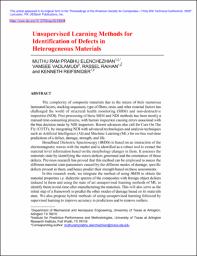
ATTENTION: The works hosted here are being migrated to a new repository that will consolidate resources, improve discoverability, and better show UTA's research impact on the global community. We will update authors as the migration progresses. Please see MavMatrix for more information.
Show simple item record
| dc.contributor.author | Elenchezhian, Muthu Ram Prabhu | |
| dc.contributor.author | Vadlamudi, Vamsee | |
| dc.contributor.author | Raihan, Rassel | |
| dc.contributor.author | Reifsnider, Kenneth | |
| dc.date.accessioned | 2020-10-21T18:39:22Z | |
| dc.date.available | 2020-10-21T18:39:22Z | |
| dc.date.issued | 2020-09-17 | |
| dc.identifier.citation | ELENCHEZHIAN, MUTHU RAM PRABHU, VAMSEE VADLAMUDI, RASSEL RAIHAN, and KENNETH REIFSNIDER. "Unsupervised Learning Methods for Identification of Defects in Heterogeneous Materials." In Proceedings of the American Society for Composites—Thirty-fifth Technical Conference. 2020. | en_US |
| dc.identifier.other | https://www.doi.org/10.12783/asc35/34900 | |
| dc.identifier.uri | http://hdl.handle.net/10106/29548 | |
| dc.description.abstract | **Please note that the full text is embargoed** ABSTRACT: The complexity of composite materials due to the nature of their numerous laminated layers, stacking sequences, type of fibers, resin, and other external factors has challenged the world of structural health monitoring (SHM) and non-destructive inspection (NDI). Post-processing of these SHM and NDI methods has been mostly a manual time-consuming process, with human inspection causing errors associated with the bias decision made by NDI inspectors. Recent advances also call for Cure On The Fly (COTF), by integrating NDI with advanced technologies and analysis techniques such as Artificial Intelligence (AI) and Machine Learning (ML) for on-line real-time predictions of a defect, damage, strength, and life.
Broadband Dielectric Spectroscopy (BbDS) is based on an interaction of the electromagnetic waves with the matter and is identified as a robust tool to extract the material level information based on the morphology changes in them. It assesses the materials state by identifying the micro-defects generated and the orientation of those defects. Previous research has proved that this method can be employed to assess the different material state parameters caused by the different modes of damage, specific defects present in them, and hence predict their strength based on these assessments.
In this research work, we integrate the method of using BbDS to obtain the material properties i.e. dielectric spectra of the composites with foreign object defects induced in them and using the state of art unsupervised learning methods of ML to identify them in real-time after manufacturing the materials. This will also serve as the initial step of a framework to predict the other modes of damage based on its materials state. We also propose hybrid methods of using unsupervised learning followed by supervised learning to improve accuracy in predictions and to remove outliers. | en_US |
| dc.description.sponsorship | Institute for Predictive Performance and Methodologies, The University of Texas at Arlington Research Institute, Fort Worth, TX | en_US |
| dc.publisher | Proceedings of the American Society for Composites—Thirty-fifth Technical Conference | en_US |
| dc.subject | Composite Materials | en_US |
| dc.subject | Machine Learning | en_US |
| dc.subject | Unsupervised Learning | en_US |
| dc.subject | Dielectric Characterization | en_US |
| dc.title | UNSUPERVISED LEARNING METHODS FOR IDENTIFICATION OF DEFECTS IN HETEROGENEOUS MATERIALS | en_US |
| dc.type | Article | en_US |
Files in this item
- Name:
- ASC_145_Paper.pdf
- Size:
- 910.3Kb
- Format:
- PDF
This item appears in the following Collection(s)
Show simple item record


